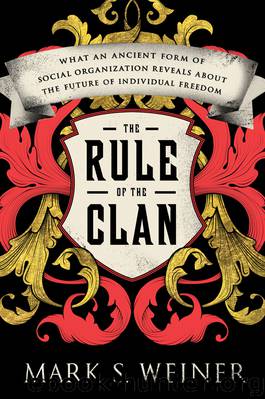The Rule of the Clan by Mark S. Weiner

Author:Mark S. Weiner
Language: eng
Format: epub
Publisher: Farrar, Straus and Giroux
TEN
“WE HAVE MADE YOU INTO NATIONS AND TRIBES”
THE VISION OF EARLY ISLAM
When the missionaries sent by Pope Gregory to convert the Anglo-Saxons landed in Kent in 597, the young merchant who would become the prophet of Islam was a recently married man.
Born around 570, Muhammad had spent his early years as a shepherd and occasional trader, gaining a reputation for honesty that earned him the nickname al-Amin, the trustworthy. In 595 he wedded a prosperous businesswoman named Khadija who had hired him to lead trade caravans to Syria and Yemen. When Muhammad began to receive revelations from the Archangel Gabriel around 610, revelations later collected as the Qur’an, Khadija became the first person other than Muhammad himself to accept the new faith of Islam.
At that point Anglo-Saxon Christianity, too, was in its relative infancy. Following the death in 616 of the first Christian Anglo-Saxon ruler, King Ethelbert of Kent, many of his subjects quickly reverted to paganism.
Thereafter, signposts of religious development in England and Arabia appear on the timeline of history in striking parallel.
In 622 Muhammad settled in Medina, migrating from Mecca to escape persecution by tribal elites (the momentous hijra marks the first year of the Islamic calendar). In 625 the pagan King Raedwald of East Anglia was buried at Sutton Hoo with two silver spoons bearing the inscriptions “Saul” and “Paul,” an indication of the growing influence of Christianity. In 627 the powerful Northumbrian king Edwin was baptized. In 630 Muhammad returned to Mecca in triumph. In 632 Abu Bakr succeeded Muhammad as the first caliph. In 635 the Irish monk Aidan founded the famed monastery at Lindisfarne. The last pagan Germanic king in England, Arwald of the Isle of Wight, died in 686. By then Islamic forces had broken out of Arabia, set siege to Constantinople, and reached the Indus River.
Although they seem worlds apart, Anglo-Saxon Christianity and early Islam developed simultaneously—two peoples converted to monotheistic faiths at the same time.
Anglo-Saxon England and seventh-century Arabia possess another important similarity as well. Just as the Germanic peoples were once governed by the rule of the clan, so the rule of the clan is inextricable from the early history of Islam—indeed, from its history as a whole. Islam was born within a tribal society; it has been adopted by societies across the globe that have strong, preexisting tribal belief systems; and Muslim thinkers have contemplated the dynamics of group solidarity (‘asabiyya) for hundreds of years. The medieval scholar Ibn Khaldun even made it central to his theory of history.1
Yet Muhammad and the early caliphs, not as outside powers but as indigenous reformers, forged a collective identity, based on a new concept of law, that sought to ameliorate many of the flaws of tribal custom. The story of early Islam is a story of a religious vision that transcended the spiritual particularism and constitutional factionalism of the rule of the clan.
Today many states with majority Muslim populations are engaged in a charged political struggle with powerful clans, including those nations emerging from the spring revolutions in the Middle East and North Africa.
Download
This site does not store any files on its server. We only index and link to content provided by other sites. Please contact the content providers to delete copyright contents if any and email us, we'll remove relevant links or contents immediately.
| Anthropology | Archaeology |
| Philosophy | Politics & Government |
| Social Sciences | Sociology |
| Women's Studies |
The Secret History by Donna Tartt(16635)
The Social Justice Warrior Handbook by Lisa De Pasquale(11490)
Thirteen Reasons Why by Jay Asher(7794)
This Is How You Lose Her by Junot Diaz(5779)
Weapons of Math Destruction by Cathy O'Neil(5040)
Zero to One by Peter Thiel(4828)
The Myth of the Strong Leader by Archie Brown(4792)
Promise Me, Dad by Joe Biden(4451)
Beartown by Fredrik Backman(4423)
Stone's Rules by Roger Stone(4418)
How Democracies Die by Steven Levitsky & Daniel Ziblatt(4401)
The Fire Next Time by James Baldwin(4345)
100 Deadly Skills by Clint Emerson(4081)
A Higher Loyalty: Truth, Lies, and Leadership by James Comey(4035)
Rise and Kill First by Ronen Bergman(4014)
The David Icke Guide to the Global Conspiracy (and how to end it) by David Icke(3885)
The Farm by Tom Rob Smith(3873)
Secrecy World by Jake Bernstein(3785)
The Doomsday Machine by Daniel Ellsberg(3734)
